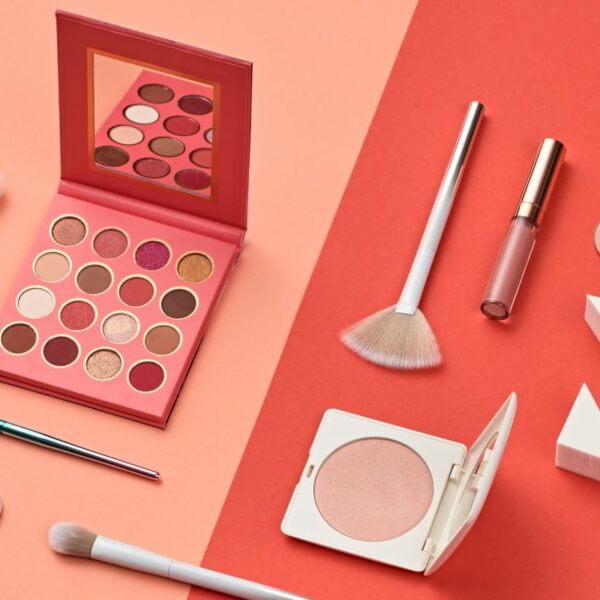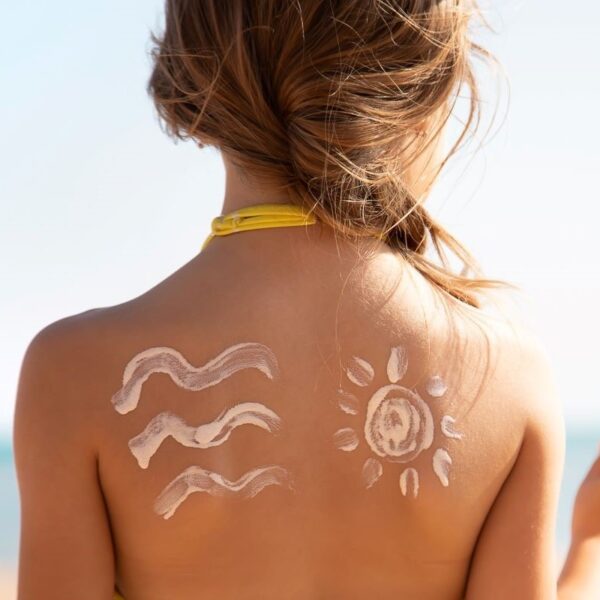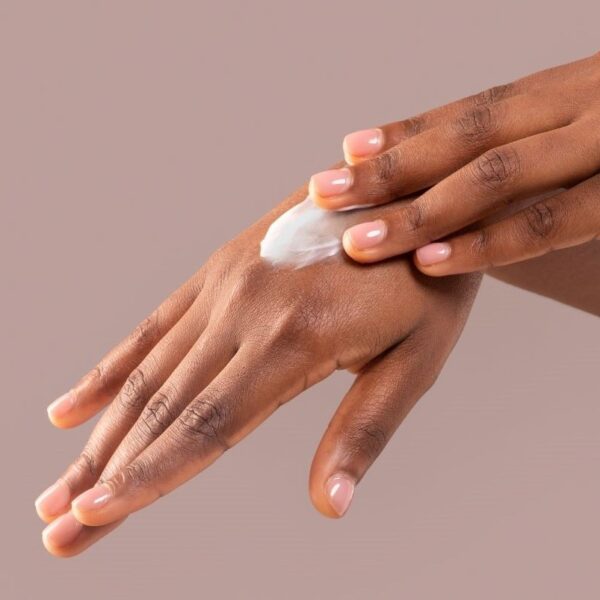Benzyl alcohol, or α-Cresol, is a colorless liquid with a light, pleasantly aromatic scent. Many plants naturally produce it, commonly found in honey, cocoa, mushrooms, and various fruits and teas. It’s also found in many essential oils, including jasmine, hyacinth, and ylang-ylang. Benzyl alcohol is used in cosmetics and personal care products as a preservative, fixative, and diluent in ointments, perfumes, soaps, and various cosmetics.
What is Benzyl Alcohol?
Benzyl alcohol is one of several aromatic alcohols. Represented as BnOH, its molecular formula is C6H5CH2OH. Benzyl alcohol serves several functions in cosmetics and personal care products. It is especially known for its performance as a solvent due to its polarity, low toxicity, and low vapor pressure.
Source: Wikipedia
How is Benzyl Alcohol Produced?
Although benzyl alcohol is found in various natural sources, it’s only in modest amounts. It’s typically manufactured synthetically for commercial and industrial purposes by treating benzyl chloride with sodium or potassium carbonate.
Applications of Benzyl Alcohol in the Personal Care Industry
In cosmetics and personal care products, benzyl alcohol functions as a fragrance, pH adjuster, preservative, solvent, and viscosity-decreasing agent.
| Function | Applications |
| Solvent | Benzyl alcohol helps to dissolve other ingredients in a product formulation, acting as a solvent. |
| Preservative | Benzyl alcohol acts as a preservative, inhibiting the development of microorganisms due to its antibacterial and antifungal properties. |
| Viscosity Controlling Agent | Benzyl alcohol also helps to alter the viscosity of cosmetic products, allowing the product to flow more easily. |
| Fragrance Ingredient | As an aromatic alcohol, benzyl alcohol is naturally fragrant and gives off a slightly sweet, floral scent. |
Product Examples
| Type | Examples |
| Skincare | Creams, Lotions |
| Hair Care | Hair Color, Shampoo, Conditioner |
| Antiperspirant/Deodorant | Deodorants |
| Baby Care | Baby Lotion, Baby Cream, Baby Shampoo |
Properties of Benzyl Alcohol
| Physical Form | Liquid |
| Color | Colorless |
| Odor | Slightly aromatic |
| Shelf Life | The recommended retest date is 24 months from the date of manufacture. |
| Molecular Weight | 108.14 g/mol |
| Appearance @ 20 °C | Transparent Liquid |
| Density @ 20 °C | 1.044 g/cm3 |
| Viscosity, cps at 20 °C | 5.474 cP |
| Melting Point | −15.2°C |
| Boiling Point | 205.3°C |
| Refractive Index | 1.5396 |
| Specific Gravity at 20 °C | 1.042 – 1.047 |
| Solubility | Soluble in water at 40 g/L @ 25°C; soluble in benzene, methanol, chloroform, ethanol, ether, and acetone. |
Recommended Storage and Handling
- Benzyl alcohol oxidizes slowly in the air to benzaldehyde and benzoic acid. It does not react with water.
- Aqueous solutions may be sterilized by filtration or autoclaving. Some solutions may generate benzaldehyde during autoclaving.
- Benzyl alcohol may be stored in metal or glass containers.
- Plastic containers should not be used. However, exceptions include polypropylene containers or vessels coated with inert fluorinated polymers such as Teflon.
- Benzyl alcohol should be stored in an airtight container, protected from light, in a cool, dry place.
- The product should be protected from freezing or excessive heat in a dry area with no possibility of coming in contact with moisture or condensation.
Typical Formulations
Body Therapy: Cleansing bar for hair & body
Produces an off-white to yellow solid bar, stable for one month at 50°C and three months at room temperature / 40°C.
| PHASE | INCI Name | TRADE Name | Supplier | % Wt. |
| A | Cetearyl alcohol | lanette O | BASF | 30 |
| Hydrogenated vegetable oil | Cegesoft HF 62 | BASF | 5 | |
| Cetearyl alcohol, Lecithin, Sodium cetearyl sulfate, Vegetable oil | Plantaquat NC | BASF | 10 | |
| Sodium lauryl sulfate | Texapon K12G | BASF | 33 | |
| Benzyl alcohol | Microcare® BNA | Thor | 0.4 | |
| B | Aqua | Demineralized water | 9 | |
| Cocamidopropyl betaine | Dehyton PK 45 | BASF | 5 | |
| Sorbitol | Beauté by Roquette® PO 070 | Roquette | 2.60 | |
| Gluconolactone | Beauté by Roquette® GA 290 | Roquette | 1 | |
| Succinic acid | Beauté by Roquette® SA 130 | Roquette | 1 | |
| Gluconic acid, Caprylyl/capryl glucoside, Cymbopogon citratus leaf extract | Beauté by Roquette® LS 007 | Roquette | 1 | |
| C | Cyclodextrin | Beauté by Roquette® CD 100 | Roquette | 2 |
Source: Knowde
Formulation Procedure
- Prepare phase A at 70°C in a separate beaker.
- At 70°C, add phase B into phase A under gentle to medium agitation. Keep agitation and temperature for 10 minutes.
- At 70 °C, add phase C.
- Pour into packaging at 60-65°C.
Safety & Regulatory Considerations
| FDA Information | Benzyl alcohol is safe in the present practices of use and concentration, according to CIR. In 2001, the Cosmetic Ingredient Review (CIR) published a final report on the safety assessment of benzyl alcohol, concluding that benzyl alcohol is safe for use in cosmetic formulations at concentrations up to 5%. Benzyl alcohol was safe for use in hair dyes at concentrations up to 10%. |
| Canada Regulations | Included in the Canadian List of Acceptable Non-medicinal Ingredients. |
| EU Information | According to the Cosmetic Products Regulation (EC) No 1223/2009 (EU, 2009b), the presence of benzyl alcohol must be indicated in the list of ingredients when it is used as a fragrance or in aromatic compositions or their raw materials and its concentration exceeds 0.001% in leave-on products and 0.01% in rinse-off products, respectively. As a preservative, the maximum allowed concentration of benzyl alcohol is 1% in ready-for-use preparations. Allergenic substances such as benzyl alcohol must be labeled on the packaging of detergents if added at concentrations exceeding 0.01% (EU Regulation No 648/2004 on detergents (EC, 2004; EMA, 2017; EFSA, 2019). |
| Cosmetic Ingredient Review (CIR) Information | Benzyl alcohol is safe in the present practices of use and concentration, according to CIR. In 2001, the Cosmetic Ingredient Review (CIR) published a final report on the safety assessment of benzyl alcohol, concluding that benzyl alcohol is safe for use in cosmetic formulations at concentrations up to 5%. Benzyl alcohol was safe for hair dyes at concentrations up to 10%. |
Safety & Toxicity of Benzyl Alcohol
A report by the European Chemicals Agency included the following findings for benzyl alcohol:
- Acute Toxicity and Irritation: No additional concern was identified. CLH proposal for acute oral toxicity and eye irritation submitted to ECHA.
- Skin sensitization: Weak to moderate skin sensitizing potential confirmed. Classification as skin sensitizer Cat. 1B justified based on positive reactions above 500 µg/cm2 in Human Repeated Insult Patch Tests (HRIPTs) and a low—but substantial—incidence of up to 0.3% in large study populations with consecutive patients in clinical departments of dermatology. CLH proposal for skin sensitization submitted to ECHA.
- Carcinogenicity: No concerns identified.
- Mutagenicity: No concerns identified.
- Dermal DNEL (local effects): DNEL shall only be seen as an upper bound “best case” DNEL estimate due to high uncertainties. It does not represent an exposure level at which no sensitization will occur in the exposed population. However, any exposure exceeding this value indicates a risk of dermal allergy.
- The conclusion from the findings of the Scientific Committee on Consumer Safety states benzyl alcohol is an “established contact allergen in humans.” (SCCS, 2012). Furthermore, the conclusion that benzyl alcohol is a weak sensitizer is also consistent with the outcomes reported in the recent Scientific Opinion by EFSA, in which the risks associated with using benzyl alcohol as a food additive were re-evaluated (EFSA, 2019).
Identification Numbers
| Chemical Name | Phenylmethanol |
| Synonyms | (Hydroxymethyl)benzene Benzenecarbinol |
| CAS Number | 100-51-6 |
| Index number in Annex VI of the CLP Regulation | 603-057-00-5 |
| EC Number | 202-859-9 |
| FEMA Number | 2137 |
Acceptable Limits or Maximum Usage
The maximum usage level of benzyl alcohol in the cosmetic industry, as per CIR, is as follows:
| Category | Usage Level (%) |
| Eye Area | 0.000008 to 0.8 % |
| Deodorant (underarm) | 0.03 to 0.5 % |
| Hair: Non-Coloring | 0.0002 to 3 % |
| Hair: Coloring | 0.00007 to 10 % |
| Nail | 0.00002 to 0.5 % |
| Baby Products | 0.004 to 0.9 % |
| Leave-on | 0.000008 to 3 % |
| Rinse-off | 0.000006 to 10 % |
| Diluted for Bath Use | 0.001 to 0.9 % |
Fun Facts About Benzyl Alcohol
- If benzyl alcohol is exposed to the air for long periods, it may smell like bitter almond because of oxidation.
- In medicine, benzyl alcohol is sometimes used as a local anesthetic to reduce pain associated with Lidocaine injection.
Additional Resources
- Wikipedia | Benzyl Alcohol
- ECHA | Directive 2009/48/EC on Certain Conditions for Toys
- Chemical Book | What is Benzyl Alcohol?
- CDC | Basics and Facts on Benzene
- CIR Safety | Final Report on Benzyl Alcohol
- CIR Safety | Draft Report on Benzyl Compounds
- ECHA | Documentation on a Chemical Directive or Regulation (Exact Topic Needs Clarification)



